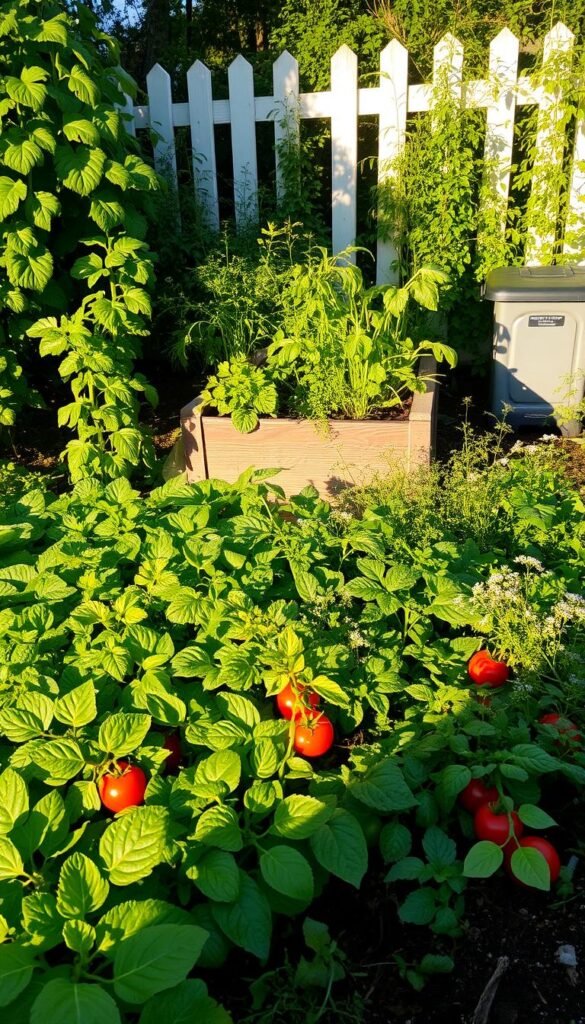Dreaming of fresh ingredients just steps from your kitchen? A manageable growing space lets you enjoy homegrown flavors without stress. Many first-timers bite off more than they can chew, turning what should be joyful into a chore. The secret? Start modestly.
A 10’x10’ plot or compact raised bed (4’x4’ works great!) keeps maintenance simple. You’ll spend less time weeding and more time savoring juicy tomatoes or crisp lettuce. Research shows beginners who limit their initial footprint harvest 30% more produce than those with oversized plots.
This approach builds confidence. You’ll master watering schedules, pest control, and soil health in a controlled area. Think of it as training wheels for your green thumb. Before long, those six basil plants might inspire an herb wall, or your pepper success could lead to vertical planters.
We’ll walk through smart layouts that maximize yield in minimal space. Learn why proper sunlight beats square footage, and how companion planting turns tiny areas into powerhouse producers. Ready to dig in?
Getting Started with Your Small Backyard Vegetable Garden
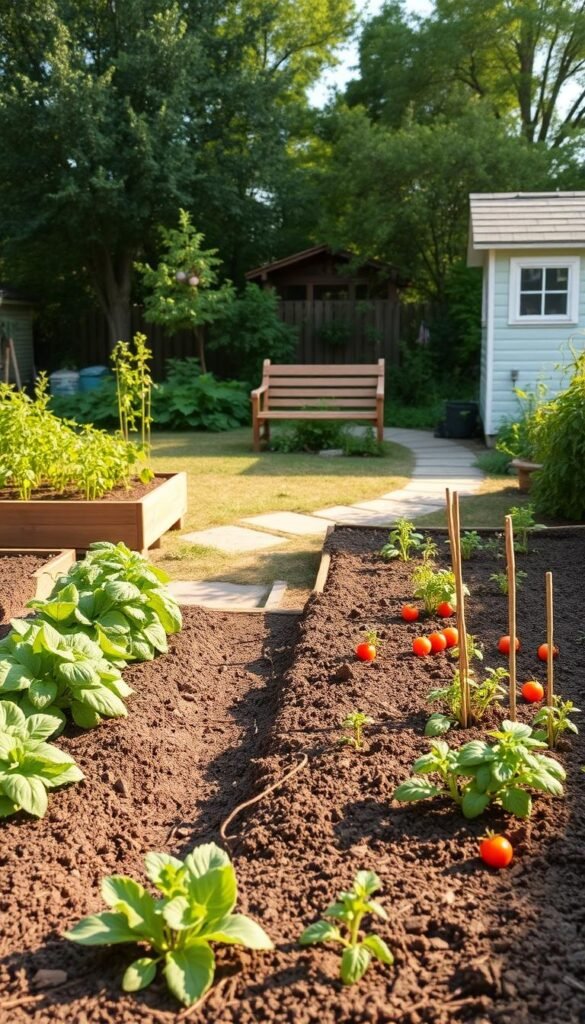
Starting your first edible plot doesn’t require endless hours or acres of land. Successful gardening begins with matching your ambitions to reality – 73% of new growers overestimate their available time according to recent surveys. This mismatch often leads to abandoned projects and wasted effort.
Here’s a reality check: A 10’x10’ space produces 80-100 lbs of food annually while needing just 2-3 weekly hours of care. Compare that to standard 20’x20’ community plots that demand 8+ hours weekly – a key reason 40% of first-timers quit within their first season.
| Plot Size | Weekly Time Commitment | First-Year Success Rate |
|---|---|---|
| 4’x4′ Raised Bed | 1-2 hours | 92% |
| 10’x10′ Ground Plot | 2-3 hours | 78% |
| 20’x20′ Traditional | 8+ hours | 41% |
Seasoned growers swear by the “three plant rule” for beginners: Choose three favorite vegetables and master their needs before expanding. This focused approach builds essential skills like pest management and watering rhythms without overwhelm.
Your available time dictates everything. Track your actual free hours for two weeks – most people discover they have 30% less gardening time than assumed. Use this insight when planning your beginners checklist to avoid maintenance burnout.
Early victories matter more than quantity. Harvesting six perfect tomatoes creates more motivation than struggling with twelve neglected crops. Remember: Compact spaces teach efficiency that serves you for life – whether you’re growing herbs on a balcony or transforming your entire yard later.
Selecting the Perfect Site and Garden Size
Where you plant matters more than how much you plant. Three key factors determine success: sunlight access, soil quality, and protection from harsh elements. Get these right, and even tricky spaces become productive.
Finding a Sunny, Well-Drained Location
Most crops need 6-8 hours of direct sun daily. Track your yard’s light patterns using a sun mapping technique:
- Check every 2 hours from 8 AM to 6 PM
- Mark shaded vs. sunny zones with sticks
- Repeat across 3 sunny days
Soil drainage tests are simple. Dig a 12” hole, fill it with water. If it drains in under 4 hours, you’re golden. Slow drainage? Build raised beds to prevent root rot.
Deciding Between Ground-Planted Beds and Raised Beds
Each option suits different needs. Ground beds cost less but require good native soil. Raised beds offer better control and earlier spring planting.
| Feature | Ground Beds | Raised Beds |
|---|---|---|
| Startup Cost | $0-$50 | $100-$300 |
| Soil Control | Limited | Full |
| Accessibility | Bends required | Knee-friendly |
Windy spots? Use low fences or shrub borders. Sloped area? Terrace beds with railroad ties. Limited space? Try vertical planters against south-facing walls.
Planning Your Garden Layout with Hardscaping and Paths
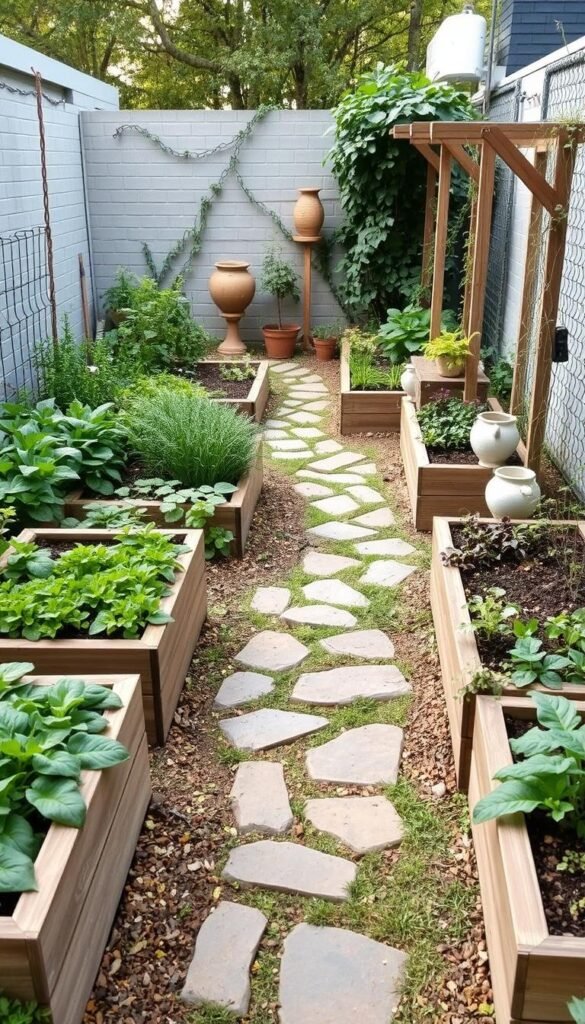
Smart layout choices transform cramped spaces into abundant harvest zones. A thoughtful design lets you tend crops comfortably while protecting soil structure. Three-foot-wide paths between beds prevent compaction – crucial for healthy root development.
Designing with Raised Beds and Square Foot Systems
The Square Foot Gardening method revolutionizes small-space growing. Divide 4’x4′ beds into 16 squares, each hosting specific plant quantities:
- 1 broccoli or tomato per square
- 4 lettuce heads per square
- 9 radishes or carrots per square
This system eliminates guesswork. You’ll know exactly how many “plants per square foot” thrive without overcrowding. Build beds narrow enough to reach the center – 4 feet wide maximizes accessibility.
Creating Accessible Garden Avenues
Path materials matter as much as their placement. Gravel or mulch prevents mud while allowing water absorption. Consider these durable options:
- Crushed granite (lasts 10+ years)
- Cedar bark chips (natural pest deterrent)
- Flagstone pavers (adds visual appeal)
Leave 18” between bed edges for wheelbarrow access. Curved pathways soften angular layouts but require more maintenance. Straight routes work best for square foot systems.
“A garden’s bones determine its longevity,” notes landscape designer Mara Lee. Incorporate permanent borders now – stone or timber edges prevent soil erosion during heavy rains. Future-you will thank present-you when expanding becomes effortless.
Small Backyard Vegetable Garden: Easy Steps to Grow Your Own Food
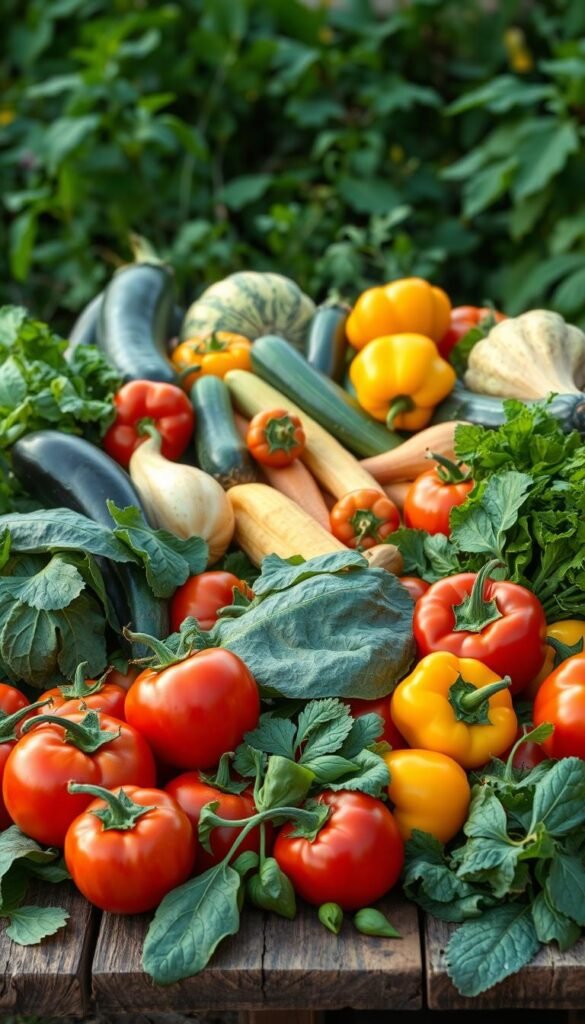
Your grocery receipts hold the key to a productive plot. Track which vegetables you buy weekly for three months – this data reveals your true priorities. Families spending $15/month on salad greens should allocate more space to lettuce than exotic peppers they rarely use.
Focus on crops with dual advantages: high nutritional value and cost efficiency. Cherry tomatoes yield 10 lbs per plant annually – that’s $40 worth at store prices. Compare that to potatoes yielding 5 lbs ($3 value) in the same space.
| High-Value Crops | Space-Efficient Choices | Yield Per Sq Ft |
|---|---|---|
| Heirloom tomatoes | Leafy greens | 8-12 lbs |
| Bell peppers | Bush beans | 1.5 lbs |
| Fresh herbs | Radishes | 20-30 roots |
Preservation potential matters. Kale keeps producing leaves all season, while zucchini must be picked daily. Plants with staggered harvests fit busy schedules better than “all at once” crops.
Try this exercise: List five meals you cook weekly. Note their main vegetables. If stir-fry appears three times, prioritize bok choy and snap peas. Love tacos? Dedicate space to cilantro and jalapeños.
Balance is crucial. Reserve 20% of your garden for fun experiments – purple carrots or golden beets add excitement without compromising staple yields. Remember: Successful growers match their dirt to their dinner plates.
Choosing What to Grow: Vegetables, Herbs, and Companion Flowers
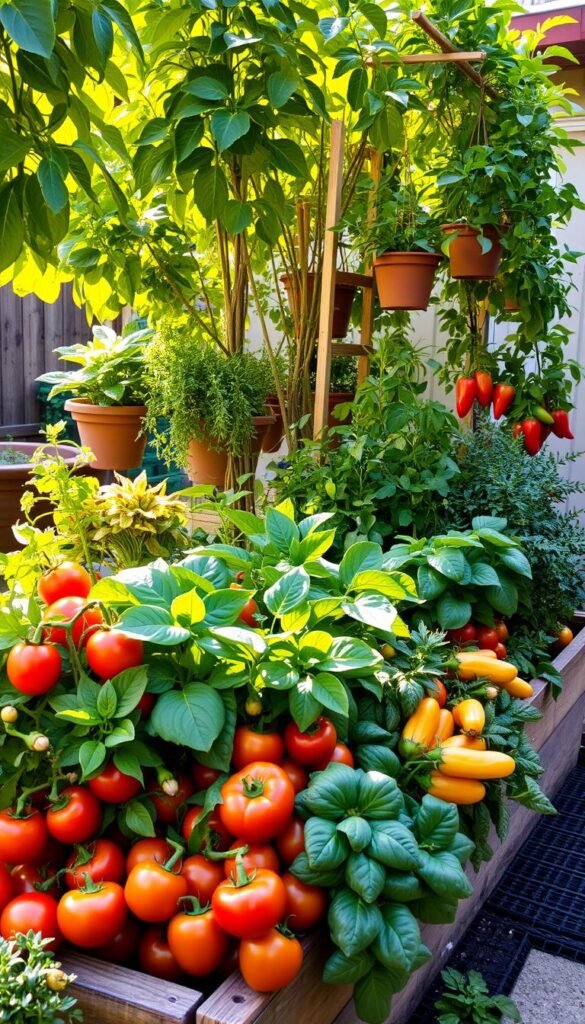
Your plate tells the story of what belongs in your plot. Start by identifying the flavors you crave most – these become your garden’s foundation. Balancing favorites with practical choices creates a thriving space that feeds both body and soul.
Grow What You Eat: Prioritizing Your Favorites
Focus on crops you’ll actually use. Track your weekly meals for patterns:
- Stir-fry fan? Prioritize snap peas and bok choy
- Taco nights? Plant cilantro and jalapeños
- Salad lover? Grow leaf lettuce and cherry tomatoes
Top performers for beginners include:
- Lettuce (harvest in 40 days)
- Bush beans (no staking needed)
- Determinate tomatoes (compact growth)
Evaluating Vegetable Characteristics for Small Spaces
Choose plants that work smarter, not harder. Look for these traits:
| Space-Saver | High Yield | Low Maintenance |
|---|---|---|
| Vertical cucumbers | Kale (6+ harvests) | Radishes (25 days) |
| Dwarf peppers | Zucchini (5 lbs/plant) | Swiss chard |
Pair crops with helpful companions. Marigolds deter beetles while nasturtiums trap aphids. Basil improves tomato flavor and repels flies – a tasty triple threat!
For guaranteed success, explore our guide to choosing the right vegetable varieties. You’ll find disease-resistant options and season-extending tips tailored to compact plots.
Planting Techniques: Seedlings, Seeds, and Timing Tips
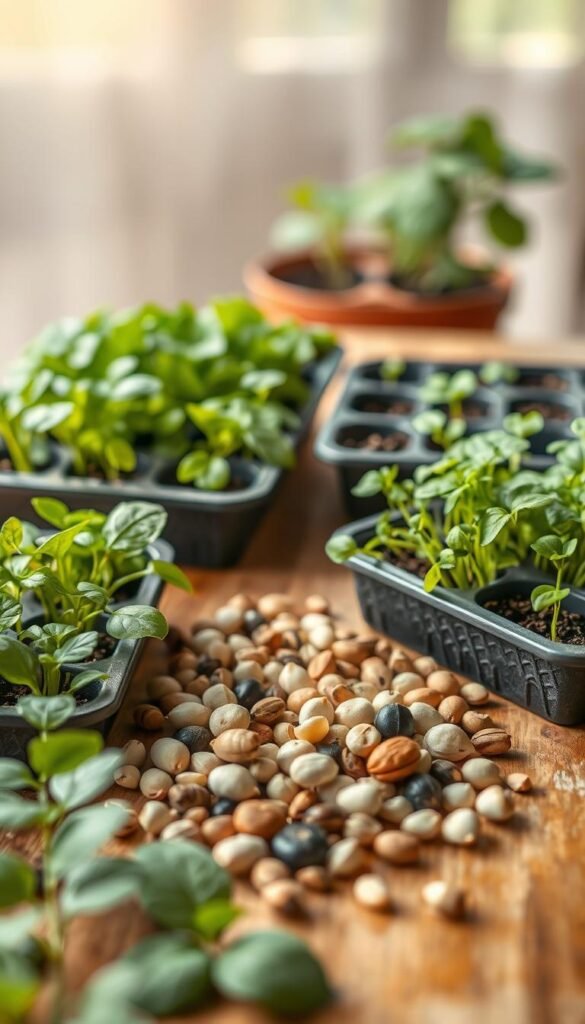
Every planting decision shapes your harvest’s success. In compact growing areas, choosing between seeds and seedlings impacts your yield and workload. Smart selections prevent gaps in your plot while maximizing flavor and productivity.
Leveraging Seedlings for a Quick Start
Young plants give you a 4-6 week head start. They’re ideal for crops like tomatoes and peppers that need long growing seasons. Here’s why they shine:
- Skip risky germination phases
- Fill spaces immediately
- Reduce daily watering needs
Nursery-grown options ensure uniform growth. For leafy greens, six purchased seedlings can fill a square foot versus 16 seeds. This efficiency matters when space equals potential meals.
| Method | Time to Harvest | Success Rate |
|---|---|---|
| Seedlings | 5-7 weeks | 95% |
| Direct Seeds | 8-12 weeks | 70% |
When sowing seeds, timing is everything. Carrots and radishes thrive when planted directly. Bury them at triple their width – tiny lettuce seeds need just ¼” depth, while beans require 1”.
Open-pollinated varieties let you save seeds for next season. Unlike hybrids, these preserve genetic traits. Tuck succession crops into harvested areas every 2-3 weeks. Spinach planted in March can be followed by beans in May, then kale in September – triple yields from one space.
Maximizing Space with Vertical Gardening and Trellises
Reach new heights by turning empty airspace into edible real estate. Vertical systems let you triple harvests without expanding your footprint. A well-designed trellis becomes both functional support and living sculpture.
Creative Support Solutions
Livestock panels offer budget-friendly versatility. Bend them into arches or lean-to structures using T-posts. For heavy producers like winter squash, reinforce with crossbars. Ready-made options simplify setup:
- Expandable pea trellises (adjusts as plants grow)
- Powder-coated cucumber ladders (rust-resistant)
- Titan squash tunnels (holds 50+ lbs)
| Trellis Type | Cost Range | Best For |
|---|---|---|
| DIY Cattle Panel | $25-$40 | Cucumbers, peas |
| Deluxe Metal Arch | $90-$120 | Gourds, pole beans |
| Modular Grid System | $150-$200 | Tomatoes, tomatillos |
Why Grow Upwards?
Vertical planting improves air circulation, reducing mold risks. Harvesting becomes back-friendly – no more crawling through foliage. Try these space-smart varieties:
- Cucumbers: Diva (seedless), Boothby’s Blonde
- Squash: Honey Nut (compact), Delicata
- Tomatoes: Sun Gold (prolific producer)
“A trellised plant yields 2-3 times more than ground-grown counterparts by optimizing sunlight exposure,” notes Gardener’s Supply Company’s research team.
Secure structures deeply – wind loads increase with plant weight. Use soft ties to avoid stem damage. Pair climbers with basil or marigolds below for pest protection and layered productivity.
Smart Garden Maintenance: Watering, Weeding, and Seasonal Adjustments
What if ten minutes daily could triple your harvest? Proper care turns compact plots into food factories. Consistency beats complexity – simple routines keep plants thriving through changing seasons.
Seasonal Care and Efficient Watering Techniques
Give roots 1″ of water weekly – but spread it out. Daily sips prevent drought stress in containers. Use this cheat sheet:
| Plant Type | Water Frequency | Best Time |
|---|---|---|
| Leafy Greens | Every 2 days | Morning |
| Tomatoes | 3x weekly | Before noon |
| Herbs | Light daily | Sunset |
Mulch is your secret weapon. A 2″ layer blocks weeds and locks in moisture. Try these options:
- Straw (lasts 3 months)
- Wood chips (deters slugs)
- Newspaper (free + effective)
Harvesting is growth fuel. Pick beans every 3 days, tomatoes when glossy. Regular picking tells plants: “Keep producing!” Letting veggies overripen signals the end.
Rotate crops each season to prevent disease. After summer tomatoes, plant garlic for winter. Clean tools with vinegar weekly – it stops blight spread.
“Gardeners who weed 5 minutes daily spend 70% less time overall than those doing weekly marathons,” reveals a Rutgers University study.
Even apartment dwellers can master these rhythms. Tending becomes meditation – notice aphids early, savor basil’s scent, watch seedlings reach for sun. Your garden grows more than food; it cultivates peace of mind.
Wrap-Up and Embrace the Joy of Harvesting Your Backyard Bounty
The true magic happens when dirt-stained hands pluck sun-warmed produce from your plot. This ritual connects you to nature’s rhythms in ways store-bought meals never can. Create moments to savor – sip tea while watching bees dance across blossoms or listen to rustling leaves as twilight falls.
Develop harvesting routines that align with meals. Gather herbs before breakfast, snip greens for lunch salads, and collect ripe veggies during evening strolls. These small acts weave gardening into daily life rather than squeezing it between obligations.
Extend the pleasure beyond growing seasons. Dry aromatic basil for winter soups. Pickle extra cucumbers using organic soil preparation techniques. Share surplus tomatoes with neighbors – generosity roots deeper than any plant.
Add comforts that invite lingering: a weathered bench under climbing beans, wind chimes that sing with summer breezes, or a birdbath attracting feathered visitors. These touches transform functional spaces into soul-nourishing retreats.
Each year, your relationship with the land deepens. You’ll notice subtle shifts – earlier bud breaks, soil that crumbles like chocolate cake, the triumphant return of fireflies. This isn’t just growing food. It’s cultivating wonder, one vibrant harvest at a time.

